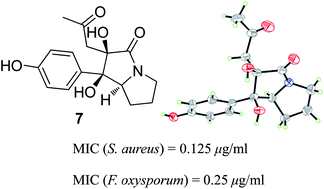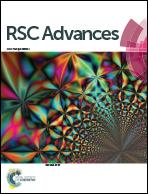Antimicrobial alkaloids produced by the mangrove endophyte Penicillium brocae MA-231 using the OSMAC approach†
Abstract
The OSMAC (one strain-many compounds) protocol was used in this study to obtain various metabolites from the mangrove-derived endophytic fungus Penicillium brocae MA-231. As a result, four new thiodiketopiperazine alkaloids, penicibrocazines F–I (1–4), together with two new N-containing p-hydroxyphenopyrrozin derivatives brocapyrrozins A and B (7 and 8) as well as six known alkaloids (5, 6, and 9–12), were identified from the extract of the Czapek culture medium of the fungus. Their structures and absolute configurations were determined through interpretation of their spectroscopic data and by X-ray crystallographic analysis. Compounds 7 and 9 exhibited potent activity against human pathogenic bacterium Staphylococcus aureus with MIC values of 0.125 and 0.5 μg mL−1, respectively.



 Please wait while we load your content...
Please wait while we load your content...